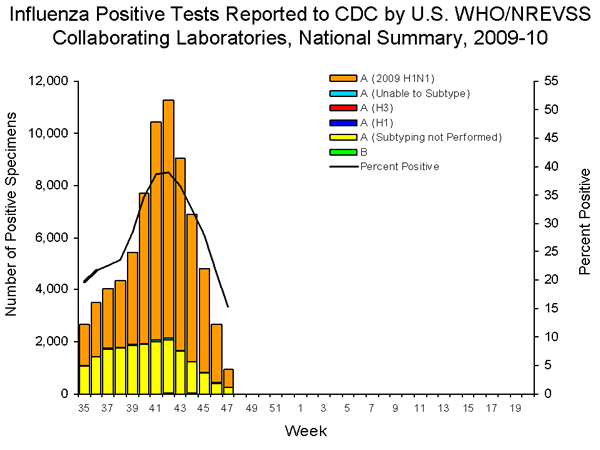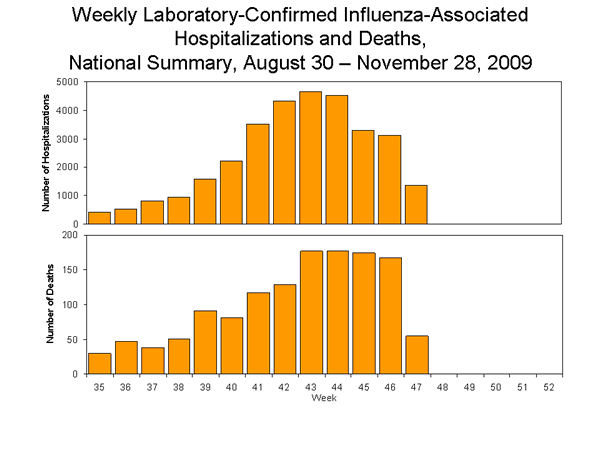Synopsis:
During week 47 (November 22-28, 2009), influenza activity continued to decrease in the U.S.
- 956 (15.4%) specimens tested by U.S. World Health Organization (WHO) and National Respiratory and Enteric Virus Surveillance System (NREVSS) collaborating laboratories and reported to CDC/Influenza Division were positive for influenza.
- Over 99% of all subtyped influenza A viruses being reported to CDC were 2009 influenza A (H1N1) viruses.
- The proportion of deaths attributed to pneumonia and influenza (P&I) was above the epidemic threshold for the ninth consecutive week.
- Seventeen influenza-associated pediatric deaths were reported. Twelve of these deaths were associated with 2009 influenza A (H1N1) virus infection and five were associated with an influenza A virus for which the subtype was undetermined.
- The proportion of outpatient visits for influenza-like illness (ILI) was 3.7% which is above the national baseline of 2.3%. Eight of the 10 regions reported ILI at or above region-specific baseline levels. Regions 6 and 10 reported ILI below their region specific baselines.
- Twenty-five states reported geographically widespread influenza activity, 17 states reported regional influenza activity, the District of Columbia, Puerto Rico and six states reported local influenza activity, and Guam, the U.S. Virgin Islands and two states reported sporadic influenza activities.

View WHO-NREVSS Regional Bar Charts | View Chart Data | View Full Screen | View PowerPoint Presentation
Pneumonia and Influenza Hospitalization and Death Tracking:
This new system was implemented on August 30, 2009, and replaces the weekly report of laboratory confirmed 2009 H1N1-related hospitalizations and deaths that began in April 2009. Jurisdictions can now report to CDC counts of hospitalizations and deaths resulting from all types or subtypes of influenza, not just those from 2009 H1N1 influenza virus. To allow jurisdictions to implement the new case definition, counts were reset to zero on August 30, 2009. From August 30 – November 28, 2009, 31,320 laboratory-confirmed influenza-associated hospitalizations and 1,336 laboratory-confirmed influenza-associated deaths were reported to CDC. CDC will continue to use its traditional surveillance systems to track the progress of the 2009-10 influenza season.

View Full Screen | View PowerPoint Presentation
Antigenic Characterization:
CDC has antigenically characterized one seasonal influenza A (H1N1), three influenza A (H3N2), four influenza B, and 499 2009 influenza A (H1N1) viruses collected since September 1, 2009.
One seasonal influenza A (H1N1) virus was tested and is related to the influenza A (H1N1) component of the 2009-10 Northern Hemisphere influenza vaccine (A/Brisbane/59/2007).
The three influenza A (H3N2) viruses tested showed reduced titers with antisera produced against A/Brisbane/10/2007, the 2009-2010 Northern Hemisphere influenza A (H3N2) vaccine component, and were antigenically related to A/Perth/16/2009, the WHO recommended influenza A (H3N2) component of the 2010 Southern Hemisphere vaccine formulation.
Influenza B viruses currently circulating globally can be divided into two distinct lineages represented by the B/Yamagata/16/88 and B/Victoria/02/87 viruses. The influenza B component of the 2009-10 vaccine belongs to the B/Victoria lineage. The four influenza B viruses tested belong to the B/Victoria lineage and are related to the influenza vaccine component for the 2009-10 Northern Hemisphere influenza vaccine (B/Brisbane/60/2008).
Four hundred ninety-eight (99.8%) of 499 2009 influenza A (H1N1) viruses tested are related to the A/California/07/2009 (H1N1) reference virus selected by WHO as the 2009 H1N1 vaccine virus and one virus (0.2%) tested showed a reduced titer with antiserum produced against A/California/07/2009.
Annual influenza vaccination is expected to provide the best protection against those virus strains that are related to the vaccine strains, but limited to no protection may be expected when the vaccine and circulating virus strains are so different as to be from different lineages. Antigenic characterization of 2009 influenza A(H1N1) viruses indicates that these viruses are only distantly related antigenically and genetically to seasonal influenza A(H1N1) viruses, suggesting that little to no protection would be expected from vaccination with seasonal influenza vaccine. It is too early in the influenza season to determine if seasonal influenza viruses will circulate widely or how well the seasonal vaccine and circulating strains will match.
Antiviral Resistance:
Since September 1, 2009, two seasonal influenza A (H1N1), five influenza A (H3N2), one influenza B, and 451 2009 influenza A (H1N1) virus isolates have been tested for resistance to the neuraminidase inhibitors (oseltamivir and zanamivir), and 1,089 2009 influenza A (H1N1) original clinical samples were tested for a single known mutation in the virus that confers oseltamivir resistance. In addition, two influenza A (H3N2) and 207 2009 influenza A (H1N1) virus isolates have been tested for resistance to the adamantanes (amantadine and rimantadine). Additional laboratories perform antiviral testing and report their results to CDC. The results of antiviral resistance testing performed on these viruses are summarized in the table below
-
To see the rest of the report/any update go to: http://www.cdc.gov/flu/weekly/
No comments:
Post a Comment